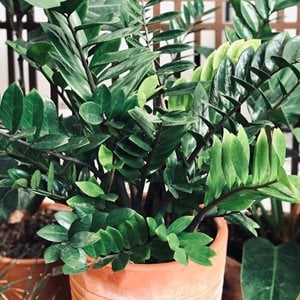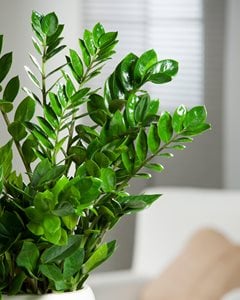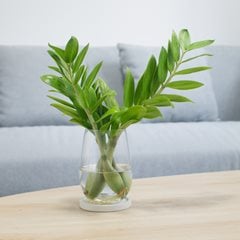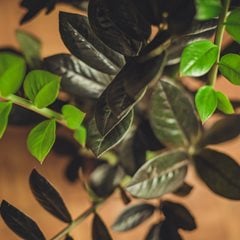The ABCs of Growing ZZ Plant
From basic care to troubleshooting tips, here’s everything you need to know about growing this trendy tropical houseplant.
Photo by: kyozstorage_stock / Shutterstock
The lush and leafy Zamioculcas zamiifolia (or ZZ plant for short) may be difficult to pronounce but couldn’t be easier to grow. Also called “Zanzibar gem” because of its African origin, ZZ plant looks exotic but is tough as nails, thriving just about anywhere with only a modicum of care.
Like snake plant, it has become a favorite among houseplant growers who love indoor greenery that doesn’t require pampering or a perfect growing environment. ZZ plant is also prized for its stunning foliage, which is so green and glossy it almost looks polished. If you want to try something even more exotic, look for newer ZZ plant varieties sporting variegated or deep purple leaves.
On this page: Basics | Growing Tips | Care | Propagation | Troubleshooting | Varieties
On this page:
BASICS
Botanical name:
Zamioculcas zamiifolia (pronounced zam-ee-oh-KUL-kass zam-ee-FOH-lee-uh)
Common names:
ZZ plant, zuzu plant, eternity plant, aroid palm, Zanzibar gem
Origin:
East Africa
Plant type:
Herbaceous perennial
Growth rate:
Slow
Height:
2 to 3 feet tall
Foliage:
Thick, waxy, pinnate leaflets range in length from 3 to 5 inches and grow alternately along the stem. Leaf color is typically dark green but can vary depending on the cultivar.
Flowers:
Although primarily a foliage plant, ZZ plant may occasionally produce flowers in the form of cream-colored spadices, similar to those of the peace lily. The flowers are small and usually hidden under the base of the leaves.
Special attributes:
- A great indoor air purifier, filtering out airborne toxins such as xylene, toluene, and benzene.
- Easy to propagate from division or leaf cuttings.
- Can be grown outdoors in summer or year-round in warmer climates (Zones 9-11)
- Grows from thick rhizomes that store water, reducing the need for frequent watering.
Toxicity:
All parts of the plant are toxic if consumed. Keep out of reach of children and pets. Also wear gloves when handling to avoid skin irritation.
GROWING ZZ PLANT

Photo by Garden World Images / Alamy Stock Photo
Light:
Low to bright indirect light, such as from a north-, east-, or west-facing window. Avoid direct sunlight, which can scorch the leaves. No windows? No problem. ZZ plant also grows well under fluorescent lighting.
Temperature:
Indoors, grow at average room temperatures of 60 to 75 degrees F. If you put your plant outdoors during the summer, be sure to bring it back inside if temperatures fall below 50 degrees F.
Humidity:
Average household humidity levels are fine, but avoid placing your plant near air conditioning and heating vents, which could dry out the air and cause browning of the leaves.
Soil:
Use a well-draining potting mix that includes perlite
Watering:
One of the rare ways you can kill a ZZ plant is by overwatering. During the active growing season (spring through early fall), only water every two weeks or when the top inch or two of soil feels dry. Water less frequently during the winter months or if growing your plant under low-light conditions.
Fertilizing:
Because ZZ plants can store nutrients in their roots, they don’t need frequent fertilization. Feed every month or so during spring and summer using an all-purpose houseplant fertilizer diluted to half the recommended rate. Do not fertilize in winter.
ZZ PLANT CARE

Photo by: Bogdan Sonjachnyi / Shutterstock
Leaf care:
To keep the foliage nice and shiny, clean with a damp cloth as needed to remove dust. Misting the leaves occasionally will also reduce dust buildup. Keeping your plant dust-free is good for its health too, because the leaves will be able take in more sunlight.
Repotting:
Since ZZ plant is a slow grower and doesn’t mind living in cramped quarters, you don’t need to repot it often. If you want to keep your plant the same size, repot it every two years or so to refresh the soil and improve drainage, putting it back in the same container after trimming away overgrown roots and stems.
If you want your plant to grow larger, put it in a new pot 1 to 2 inches in diameter wider than the current one. Because ZZ plant’s rhizomes spread laterally, its width is controlled by the diameter of the pot.
Pruning and shaping:
Pruning a ZZ plant won’t encourage new growth as with most other houseplants, but sometimes it’s necessary to improve the shape of your plant and to remove yellowing or damaged foliage.
If your plant is overgrown, you can remove entire stalks by cutting them away at the base with a sharp knife or pruning scissors. Be sure to wear gloves to avoid skin contact.
ZZ PLANT PROPAGATION

Photo by: Monster e / Shutterstock
ZZ plants can be propagated three ways:
- Division: Divide the rhizomes into clumps having at least one leaf stalk and replant the divisions in new pots filled with fresh soil. A good time to do this is when you are repotting.
- Leaf cuttings: When taking leaf cuttings, leave a bit of the stem attached and insert the stems directly in moist potting soil. Place them in a warm, brightly lit area and water occasionally. The cuttings will begin to form roots after several months’ time. A good time to do this is when pruning or shaping your ZZ plant.
- Leaf stalk: A faster propagation method is to cut off an entire leaf stalk at the base and place it in water until roots form.
TROUBLESHOOTING
Yellowing leaves:
Usually a sign of overwatering, especially if the stalks are turning brown and mushy. Prune off the damage and wait until your plant dries out before watering again. You may also need to change the soil and repot your plant to prevent root rot.
Brown leaf tips:
Probably due to low humidity, underwatering, or exposure to bright sunlight. Move your plant to a location that receives indirect light, and if the air is dry, mist the leaves occasionally.
Plant is leaning to one side:
Overwatering is the most common cause, resulting in waterlogged roots that can no longer provide good support. Your plant may also be seeking more light. Try moving it closer to a window or grow under fluorescent lighting or LED grow lights.
Pests:
ZZ plants are generally pest-free but may occasionally be bothered by mealybugs, scale, aphids, and spider mites. Good treatments for getting rid of these insects include washing the leaves with an insecticidal soap and applying organic neem oil. (See more on common houseplant pests.)
ZZ PLANT VARIETIES

'Raven' ZZ plant foliage. Photo by: Premyslaw Zielinski / Shutterstock
ln addition to the classic ZZ plant, there are several great cultivars worth seeking out. If you can’t find them at a local garden center, many online nurseries will carry them.
'Raven'™:
One of the newest ZZ varieties and one of the most dramatic, with leaves that emerge a bright lime-green color and gradually turn a deep purple, almost black shade as they mature.'Variegated':
Has green foliage enhanced by splashes of creamy white. Variegation is less pronounced if the plant is grown under low-light conditions.'Zamicro':
A dwarf version that grows slightly smaller (under 2 feet in height) with a more slender leaf shape.'Zenzi':
Another dwarf variety (no taller than 15 inches) with smaller, slightly curled leaves.
RELATED:
Best Low-Light Houseplants
The Best Philodendrons to Grow Indoors
A Guide to Growing Peace Lily
21 Best Indoor Plants
